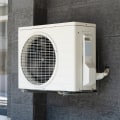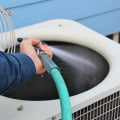Can You Be Allergic to Air Conditioning
As we seek convenience in the cool air provided by air conditioning systems, it might come as a surprise to some that these extreme systems could be triggering allergies in people. The concern emerges: can you be allergic to air conditioning? The response depends on the prospective irritants prowling within these systems, distributing through the air we breathe. Understanding the common offenders and their influence on indoor air quality is essential for those vulnerable to allergic reactions. Symptoms may manifest discreetly, making it important to check out the complexities of AC-related allergic reactions for efficient management strategies.
Common Allergens in A/c Systems
In air conditioning systems, typical irritants such as dust mites, mold spores, and animal dander can circulate and activate allergies in sensitive people. These allergens are known to be potent allergy activates, triggering symptoms like sneezing, coughing, wheezing, and itchy eyes in those who are allergic. To alleviate the presence of these irritants in air conditioner systems, the usage of pollen filters is vital. Pollen filters are designed to record and trap pollen, dust termites, mold spores, and other airborne particles, preventing them from recirculating in the indoor air. By frequently changing and preserving these filters, the concentration of irritants in the air conditioning system can be considerably minimized, offering relief to individuals prone to allergic reactions. Guaranteeing the cleanliness of the system and integrating appropriate ventilation practices can even help reduce the spread of these irritants, producing a much healthier indoor environment for all residents.
Indoor Air Quality and Allergies
Ensuring ideal indoor air quality is vital for managing allergic reactions and developing a much healthier living environment. Pollen direct exposure and family pet dander impacts are significant aspects that can intensify allergic reactions inside your home. Pollen carried into homes through open windows or on clothes, can activate allergic responses in sensitive people. Setting up appropriate air filtration systems can help decrease pollen levels inside, offering relief for those prone to allergic reactions.
Pet dander, consisting of small flecks of skin shed by animals with fur or feathers, is another common indoor irritant. These allergens can linger in the air and on surface areas, causing discomfort for allergy sufferers. Regular grooming of family pets and frequent cleansing of carpets and upholstery can assist reduce the effect of animal dander on indoor air quality. In addition, using air purifiers equipped with HEPA filters can capture and get rid of pet dander particles, enhancing the total air quality in the home. By dealing with pollen exposure and pet dander effects, individuals can develop a more allergy-friendly indoor environment.
Mold and Mildew Growth
The growth of mold and mildew in air conditioning systems can lead to the circulation of harmful mold spores in indoor air, posing risks to individuals with breathing sensitivities. Damp air conditions within air conditioning systems produce a perfect environment for mold and mildew to thrive, even more worsening potential health hazards. Understanding and addressing the existence of mold and mildew development is essential in maintaining indoor air quality and minimizing the probability of respiratory inflammation for occupants.
Mold Spores Circulation
Exposure to flowing mold spores can worsen allergies and breathing problems for people conscious of mold and mildew growth. Mold spores can easily become airborne and spread through ventilation systems, causing increased exposure inside. Together with mold spores, pollen direct exposure can likewise trigger allergic reactions, intensifying breathing distress for vulnerable people. Implementing efficient ventilation strategies, such as utilizing HEPA filters and making sure of correct airflow, can assist minimize the concentration of mold spores and other allergens in indoor environments. Regular upkeep of HVAC systems and attending to any water leakages immediately can, even more, avoid the expansion of mold and mildew, mitigating the risk of respiratory issues associated with mold spores flow.
Damp Air Conditions
In damp environments, the presence of moisture promotes the development of mold and mildew, leading to prospective health threats for people exposed to damp air conditions. High humidity levels develop a perfect breeding ground for these allergens, which can prosper in inadequately aerated areas. Ventilation systems play an essential role in managing wetness levels and avoiding the build-up of mold and mildew. Appropriate ventilation helps in decreasing humidity and flowing fresh air, preventing the development of these hazardous substances. Individuals sensitive to mold and mildew might experience allergic responses when exposed to damp air conditions, highlighting the significance of controlling humidity levels and ensuring adequate airflow through reliable ventilation systems. Regular maintenance of ventilation systems is important to reduce the threats related to mold and mildew development.
Respiratory Irritation Risks
In the middle of the challenges posed by mold and mildew development, people exposed to damp air conditions face heightened threats of breathing irritation. Mold and mildew thrive in damp environments, such as those frequently discovered in air conditioning systems, ducts, or filters. These fungi release spores into the air, which when inhaled, can set off allergies and breathing issues in delicate people. In addition to mold and mildew, wet air conditions can also worsen breathing issues by increasing pollen exposure and the blood circulation of outdoor toxins. Those with asthma or allergic reactions might experience worse signs when exposed to these pollutants, highlighting the value of appropriate maintenance and regular cleansing of air conditioning systems to alleviate respiratory dangers connected with mold and mildew development.
Dust Mites in Air Ducts
Nesting comfortably within air ducts, dust mites flourish in the dark, dirty environments created by central air systems. These tiny pests can worsen allergies and respiratory issues in vulnerable individuals. To avoid allergens from infesting ducts, routine cleaning and upkeep are important. Allergen avoidance methods include using allergen-proof covers on bed linen, washing linens frequently in hot water, and vacuuming carpets and upholstery with a HEPA filter vacuum cleaner.
In addition to preventive steps, utilizing air filtration techniques can help reduce dust mite populations in ducts. Air purifiers with HEPA filters can trap air-borne particles, consisting of allergen irritants, thus improving indoor air quality. UV germicidal lamps installed in ducts can likewise assist get rid of dust mites and other harmful bacteria. By combining these methods, people can lessen the existence of allergens in air ducts and minimize possible allergies activated by these typical indoor allergens.
Filters and Allergy Prevention
To effectively fight allergies caused by air conditioning, understanding different filter types and implementing proper maintenance tips is vital. Filters play a crucial function in trapping irritants like dust mites and pollen, hence picking the ideal filter can considerably decrease allergic reaction symptoms. Regularly cleaning or changing filters can ensure optimal air quality and lessen the threat of allergic reactions.
Filter Types
What types of air filters are most efficient in preventing allergic reactions related to air conditioning systems? When it pertains to filters and allergic reaction prevention, the efficiency and routine replacement of filters are essential. High-efficiency filters, like HEPA filters, are known to be highly reliable in trapping irritants such as dust, pollen, and pet dander. These filters can capture particles as small as 0.3 microns, substantially minimizing allergens in the air. In addition, ensuring the filter size matches the air conditioning system and installing it properly can optimize its performance. Proper installation avoids air leakage around the filter, ensuring that all air goes through the filter before flowing back into the room.
Maintenance Tips
Reliable upkeep of air filters is necessary for preventing allergies related to air conditioning systems. Routinely changing or cleaning up filters assists enhance indoor air quality by lowering the existence of irritants like dust, pollen, and pet dander. This upkeep not only safeguards against allergies but also enhances energy efficiency and temperature control within the home. Blocked filters require the air conditioning system to work harder, causing increased energy usage and possible temperature level inconsistencies. By preserving tidy filters, the system can operate more effectively, resulting in lower energy costs and much better temperature level guidelines throughout your house. For that reason, staying diligent with filter upkeep is important for allergic reaction avoidance, energy effectiveness, and optimal temperature control in air-conditioned spaces.
Symptoms of Air Conditioner Allergies
Common signs of air conditioning allergies consist of sneezing, coughing, and watery eyes. These reactions can be activated by numerous allergens present in the air conditioning system, such as pollen and family pet dander. When the air conditioner unit is not correctly maintained, it can become a breeding place for allergens, resulting in these uneasy signs.
Pollen direct exposure is a common reason for allergic reactions, particularly throughout seasons when pollen counts are high. The air conditioning system can distribute pollen particles throughout the indoor environment, triggering allergies in sensitive people. Likewise, family pet dander allergies can also be exacerbated by air conditioning systems that are not properly cleaned up and kept. Pet dander, which includes small flecks of skin shed by animals, can build up in the air conditioner filters and ducts, activating allergic symptoms in vulnerable people.
It is necessary to understand these common symptoms and their potential causes to effectively handle air conditioning allergic reactions and guarantee a much healthier indoor environment.
Managing A/c Allergy Symptoms
To minimize signs of air conditioning allergic reactions, carrying out correct upkeep practices for your air conditioning system is important. Regularly changing filters, cleaning up ducts, and making sure the system is without mold and dust can help reduce allergens circulating in the air. Additionally, considering allergy relief methods such as utilizing hypoallergenic bedding, keeping windows closed throughout high pollen seasons, and vacuuming often can even lessen exposure to allergens inside.
Investing in an air cleanser can also be beneficial for managing a/c allergic reaction symptoms. Air cleaners can help filter out particles such as dust, pollen, pet dander, and mold spores from the air, supplying cleaner and fresher indoor air quality. When choosing an air cleanser, look for one with a HEPA filter, as these are extremely efficient at capturing little particles that can set off allergic reactions.
Frequently Asked Questions
Can Air Conditioning Worsen Existing Allergies or Asthma Symptoms?
Air conditioning can worsen allergies or asthma by flowing indoor toxins, such as dust mites or pet dander. Furthermore, if not correctly preserved, air conditioners can harbor mold or germs, activating symptoms. Pollen exposure can likewise intensify signs.
Is It Possible for Air Conditioning to Cause Skin Irritation or Rashes in Individuals With Sensitive Skin?
Individuals with skin level of sensitivity may experience irritation from indoor pollutants flowed by air conditioning. Dust, mold, and other allergens can exacerbate skin problems. Correct upkeep, purification, and humidity control can assist reduce skin responses.
Are There Any Long-Term Health Effects Associated With Being Allergic to Air Conditioning?
Direct exposure to indoor toxins from air conditioning systems can pose a danger to breathing health for individuals with allergies. Long-lasting effects might consist of worsening asthma signs, increased allergic reactions, and breathing infections. Routine maintenance and air quality assessments are suggested.
Can Air Conditioning Allergies Be Passed Down Genetically?
Genetic inheritance plays a function in the development of allergies. Ecological aspects can also add to increased susceptibility. Therefore, it is plausible that air conditioning allergic reactions could be passed down genetically, intensified by environmental triggers.
Are There Any Natural Remedies or Alternative Solutions for Managing Air Conditioning Allergies Besides Medication?
Natural solutions and holistic methods offer alternative solutions to handling air conditioning allergic reactions. Lifestyle modifications like using air purifiers or essential oils can help. Environmental changes such as keeping filters tidy and keeping indoor humidity levels can likewise relieve symptoms.










